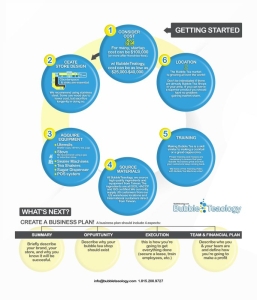

Understand the costs of starting a bubble tea business, including hidden costs and tips for budgeting effectively.
Starting a bubble tea business involves a range of upfront investments. These costs are essential to get your business off the ground and ensure a smooth opening. By understanding and planning for these initial expenses, you can avoid surprises and set your business up for success.
One of the biggest investments in starting a bubble tea business is purchasing the necessary equipment. You’ll need items like a bubble tea sealer machine, fructose dispenser, and shaker machine. These tools are vital for producing consistent, high-quality drinks that keep customers coming back. While it might be tempting to cut costs by purchasing cheaper equipment, investing in reliable, durable machines will save you money in the long run by reducing maintenance and replacement costs.
Securing a location for your bubble tea shop is another significant cost. Depending on the location, rent can vary widely. In addition to leasing the space, you’ll likely need to invest in renovations to make the space suitable for your business. This could include installing counters, seating, and necessary plumbing for your equipment. Renovation costs can add up quickly, so it’s important to budget carefully and get multiple quotes to ensure you’re getting a fair price.
Before opening your doors, you’ll need to secure various licenses and permits. These might include health permits, food handling certifications, and business licenses. The costs of these permits can vary depending on your location, but they are non-negotiable expenses necessary for operating legally. Failing to obtain the proper licenses can lead to fines or even closure, so it’s crucial to factor these costs into your budget from the start.
Your initial inventory will include the ingredients needed to make bubble tea, such as tapioca pearls, tea leaves, flavored syrups, and other toppings. Additionally, you’ll need supplies like cups, straws, and sealing film. It’s important to purchase enough inventory to meet initial demand without overstocking, as some ingredients have limited shelf lives. Partnering with reliable suppliers can help ensure you always have fresh ingredients on hand.
Creating a strong brand and marketing plan is crucial for attracting customers to your new business. This can include costs for designing a logo, printing signage, creating a website, and running initial advertising campaigns. Effective branding helps distinguish your business from competitors and builds customer loyalty. Investing in professional branding and marketing services can provide a strong foundation for your business’s reputation.
Even with careful planning, unexpected costs are almost inevitable. These could range from additional legal fees to unforeseen construction expenses. It’s wise to set aside a contingency fund to cover these unexpected costs. A good rule of thumb is to reserve 10-20% of your total start-up budget for contingencies. This will give you the flexibility to handle surprises without derailing your business launch.
Once your bubble tea business is up and running, it’s crucial to manage ongoing operational expenses effectively. These recurring costs are vital to keep your business functioning smoothly and maintaining profitability. Proper budgeting for these expenses will ensure that your business remains sustainable in the long term.
One of the most significant ongoing expenses for your bubble tea business will be rent. The cost of your lease will depend heavily on the location of your shop. Prime locations with high foot traffic often come with higher rent prices but can also lead to greater sales. In addition to rent, you’ll need to budget for utilities like electricity, water, and gas, which are necessary for running your equipment and maintaining a comfortable environment for your customers.
Staffing is another substantial ongoing expense. Depending on the size of your business, you may need to hire several employees to manage daily operations, from taking orders to preparing drinks. It’s important to offer competitive wages to attract and retain skilled workers. Additionally, consider budgeting for employee benefits such as health insurance, paid time off, and staff training, which can improve employee satisfaction and reduce turnover.
Keeping your inventory stocked with fresh ingredients is crucial for meeting customer demand and maintaining product quality. Inventory costs will fluctuate based on the volume of sales, the season, and changes in supplier prices. It’s essential to establish a system for tracking inventory levels and ordering supplies in a timely manner to avoid shortages or overstocking. Building relationships with reliable suppliers can help you negotiate better prices and ensure consistent delivery of high-quality ingredients.
Regular maintenance of your bubble tea equipment is essential to avoid breakdowns that can disrupt your business. Scheduled maintenance can help prevent more costly repairs and extend the life of your machines. However, unexpected repairs can still occur, and it’s important to budget for these potential expenses. Keeping spare parts on hand and working with a reliable repair service can minimize downtime and keep your business running smoothly.
Even after your business is established, ongoing marketing efforts are necessary to attract new customers and retain existing ones. This can include social media advertising, special promotions, loyalty programs, and local community events. Consistent marketing helps keep your brand top-of-mind for customers and drives sales, especially during slow periods. Allocating a portion of your budget to ongoing marketing will ensure your business continues to grow.
Insurance is a critical ongoing expense that protects your business from various risks, including liability, property damage, and employee injuries. The cost of insurance will vary based on the coverage you choose and the size of your business. Additionally, staying compliant with local health and safety regulations may require periodic renewals of permits and inspections, which also incur costs. Ensuring that your business is properly insured and compliant with all regulations helps safeguard against potential legal and financial issues.
As your bubble tea business becomes established, planning for growth and expansion is essential to ensure continued success. This phase involves strategic investments that can help scale your business, increase revenue, and strengthen your market position. By budgeting and preparing for these future expenses, you can take your bubble tea shop to the next level.
As your business grows, you may need to invest in additional equipment to meet increased demand or expand your menu offerings. This could include purchasing more bubble tea machines, blenders, or an automatic tea brewer to speed up preparation times and improve service efficiency. Upgrading or adding equipment requires careful budgeting, as these investments can be costly but are crucial for scaling your operations.
Expanding your business often means hiring more staff to manage the increased workload. With more employees, you’ll also need to invest in additional training to ensure consistent product quality and customer service. Training programs can range from initial onboarding to advanced skills development, depending on your business’s needs. Budgeting for recruitment, wages, and training is essential to maintain a well-functioning and professional team as your business grows.
To attract a broader customer base, you may consider expanding your menu with new flavors, toppings, or even complementary food items. This expansion will require additional inventory, which must be carefully managed to avoid waste and ensure freshness. Testing new products and gauging customer response is also important, and it may involve promotional campaigns or special offers. Allocating funds for research and development, as well as increased inventory, will support your business’s growth in this area.
As your business expands, refreshing your marketing and branding efforts can help maintain customer interest and attract new audiences. This might include redesigning your logo, updating your website, launching new advertising campaigns, or even rebranding to better reflect your growing business. A strong, updated brand can differentiate you from competitors and reinforce customer loyalty. Budgeting for professional marketing and branding services ensures that your business continues to resonate with your target market.
If your current location becomes too small to accommodate your growing customer base, or if you wish to open additional locations, renovation or relocation may be necessary. These processes can be expensive, involving everything from construction to new leases and permits. Planning for these costs in advance allows for a smoother transition and minimizes disruptions to your business operations.
As with any business, growth can bring unexpected challenges. Whether it’s a sudden need for equipment replacement, a dip in sales, or an economic downturn, having an emergency fund is critical. This fund acts as a financial cushion, enabling you to manage unforeseen expenses without jeopardizing your business’s stability. Setting aside a portion of your profits regularly will help ensure that you’re prepared for any unexpected costs that come with expansion.
In conclusion, starting a bubble tea business involves a variety of costs that require careful planning and budgeting. From the initial investment in equipment and inventory to ongoing operational expenses, understanding these costs is crucial for long-term success. Additionally, as your business grows, planning for expansion and setting aside funds for unexpected expenses will help you navigate the challenges of scaling your operations.
BubbleTeaology is your best partner in this journey. We provide top-quality bubble tea machines, custom cups, and expert support to help your business thrive. Whether you’re just starting out or looking to expand, our products and services are designed to meet your needs and ensure your success.
Contact BubbleTeaology Today to learn more about how we can help you start and grow your bubble tea business!
For those new to bubble tea, here’s an informative article to learn more about BubbleTea.
Q: What are the biggest initial costs when starting a bubble tea business?
A: The biggest initial costs typically include purchasing equipment like sealer machines, shakers, and fructose dispensers, securing a lease, and renovating your space. Additionally, you’ll need to budget for inventory, branding, and marketing expenses.
Q: How much should I budget for ongoing operational expenses?
A: Ongoing operational expenses vary depending on your location and business size but generally include rent, utilities, employee wages, inventory restocking, and maintenance. It’s important to monitor these costs closely to ensure profitability.
Q: How can I minimize costs when starting a bubble tea business?
A: To minimize costs, consider starting with a smaller location, purchasing high-quality but essential equipment, and gradually expanding your inventory as your business grows. It’s also helpful to build strong relationships with suppliers to negotiate better prices.
Q: What unexpected costs should I prepare for when starting my bubble tea business?
A: Unexpected costs can include additional renovations, emergency equipment repairs, or fluctuations in inventory prices. It’s wise to set aside a contingency fund of 10-20% of your initial budget to cover these surprises.
Q: How can BubbleTeaology help me manage the costs of starting a bubble tea business?
A: BubbleTeaology provides premium bubble tea machines, custom products, and ongoing support to help you manage costs effectively. Our reliable equipment reduces the need for frequent repairs, and our expert advice ensures you make informed financial decisions.
Copyright © 2023 BubbleTeaology. All Rights Reserved.